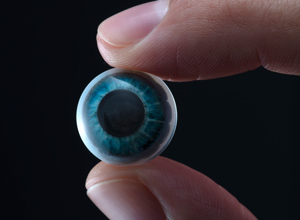
Photos for this story courtesy of Mojo Vision
|
This week, wearable technology company Mojo Vision announced that it is collaborating with contact lens maker Menicon to develop smart contact lens products. The move marks an important step forward for the California-based company, which for the past three years has been developing the Mojo Lens, a sensor-enabled contact lens that can give the wearer augmented reality viewing capability. To date, the only smart, sensor-enabled contact lenses on the market is the Sensimed Triggerfish, which provides an automated recording of continuous ocular dimensional change over 24 hours and was approved by the U.S. Food and Drug Administration (FDA) in 2016.
Mojo Vision is actively working with the FDA through its Breakthrough Devices Program, a voluntary program designed to provide safe and timely access to medical devices that can help treat irreversibly debilitating diseases or conditions. Low vision patients are among the initial target market for Mojo Lens, which is not yet available for sale. The company has several optometrists on its team who providing advice about ocular health, contact lens fitting and dispensing.
To learn more about Mojo Vision’s pioneering work in smart contact lenses, I spoke, via Zoom, with Dr. Michael Wiemer, the company’s co-founder, vice president, engineering and chief technical officer. He shared his insights about how an augmented reality device worn on the eye could change the way we receive information and navigate both the real and virtual worlds.
Our conversation has been edited and condensed for length and clarity.

Mike Wiemer
|
Vision Monday: Let’s talk about the differences between smart glasses and Mojo’s smart contact lenses. So far, smart glasses have had limited appeal to consumers, although they’re becoming more widely used in industry. How is the Mojo design team deciding what features are essential for a smart contact lens, and how do those features differ from what we’ve seen to date in various types of smart glasses?
Mike Wiemer: We hope that the smart glasses companies win at making glasses for everyone. Their success will float all boats, including ours. Everyone working in the augmented reality field is trying to make something happen.
Smart glasses haven’t found that core set of features and form factor that is really going to have mass appeal. Part of the reason is the social tax. If you wear a big set of things on your face you immediately stand out. Part of our approach, and what’s different, is that by being a contact lens, we have different form factor and an opportunity to set a different norm for how people look when they’re wearing it. We want to let you look like you and be human, and connect with people in an eyes-up way and still have access to the information you want. We believe we can make this look very natural in your eye.
There are other differences as well. For example, you can close your eye and still see. I can tell you from personal experience that it’s really cool to do that sort of thing.
Another major difference is because it’s a display in a contact lens that fits on your eye, no matter where your eye points, the display is going with you. No matter where you look you have content that can be displayed. Unlike glasses, there’s no limit to the field of view.
Just as for vision correction, some people might choose glasses and some might choose contact lenses for different activities, like sports. The differences give the product a set of unique opportunities for its user that glasses don’t provide.
VM: Is tracking and displaying health data an essential part of the basic feature set for Mojo Lens?
MW: Absolutely. We could offer the ability to bring data such as heart rate to your attention with even less friction than having to take out your phone or look at your watch. All you need is two contact lenses and an accessory device which has some type of computer and network interface, and which is also a wearable device.
VM: Explain how the retinal display technology in Mojo Lens works.
MW: There’s a display chip that we make which is 14,000 pixels per inch (PPI) It’s a very dense display. (For comparison, the iPhone 11 display is 458 PPI.) That display is placed more or less in the center of your pupil. It’s so small that it barely blocks any light. You just get a slight dimming of the environment. It doesn’t block your field of view in any way. You still see the world normally.
There’s a little optic that goes on top of that display. That optic captures the light from the display and focuses it onto your retina. Nominally, we point that display light at the fovea, but we have the capacity to tilt that and point it toward different portions of the retina.
One of our early applications is as an aid for those with visual impairments. Built into the system we have a very tiny image sensor that points out from the contact lens, and that image sensor captures data of what you’re looking at. And that data, without leaving the contact lens, can be enhanced with contrast enhancement or edge detection and that image is shown on the display. You see the real world, but with edges, for example, on everything you’re looking at. If you have damage to your fovea that whole system could be tilted a little off your fovea to a portion of the retina that is healthy.
We also have a magnification feature built into the system. One interesting thing to think about with that is if you took an image of the real world that you’re looking at—for example, what you’re looking at on the screen now—and zoomed it in by 2x and put it on our display, you would see the real world in 1x, and overlaid on top of that you would see a green image at 2x magnification. These two things could be in some sort of visual dissonance, because you’re looking at one image overlaid on top of the other. One way to resolve that is to just close your eyes, block out the real world and inspect the zoomed in image, and then dismiss it and go back to the real world.
VM: In addition to addressing certain low vision issues, the Mojo Lens addresses presbyopia. How does that work?
MW: The Mojo device itself is not intended to directly address presbyopia. There are features I can imagine that we’re building in that could help a presbyope see things. For example, in the case of that outward facing sensor, piping enhanced imagery over to the eye could probably help you read text a little closer than you’re comfortable. But that’s for our company to prove. First and foremost, though, it isn’t an accommodating lens that’s correcting presbyopia.
We do have views on how to make such a lens though. One of the things that’s particularly exciting about what we’re doing is if we’re right, that smart contact lenses are a thing, and that this thing is going to grow in the future, there’s a human technical capacity to make such objects and systems, and there’s a market to purchase them. If this beautiful cycle continues, there are so many things that can be done in the form factor of a contact lens. And making a solution for presbyopes is absolutely one of those things that can be done.
When you think about the technology that we’ve created in displays and optics and oxygenating contact lenses and control and communications and architecture of how you fit smarts into a contact lens, this is just the beginning. Our view is that over the next 10 to 20 years, there are many different products or additional features to add into a contact lens platform to address many different things from presbyopia to other kinds of eye health issues or biological quantities that can be measured in the form of a contact lens.
This is a unique wearable in that it’s about as close to your body as you can put a wearable without using a knife. It’s actually in contact with biological fluids in the form of tears. It’s in intimate physical contact. It’s not like a watch where you have to strap it down and tighten it if you want to make better contact with your skin. It remains to be proven that there is this virtuous cycle of product capability and market opportunity, and that’s what we hope to prove. But we think if we can the future is very bright and full of many different kinds of invisible computing-type products.